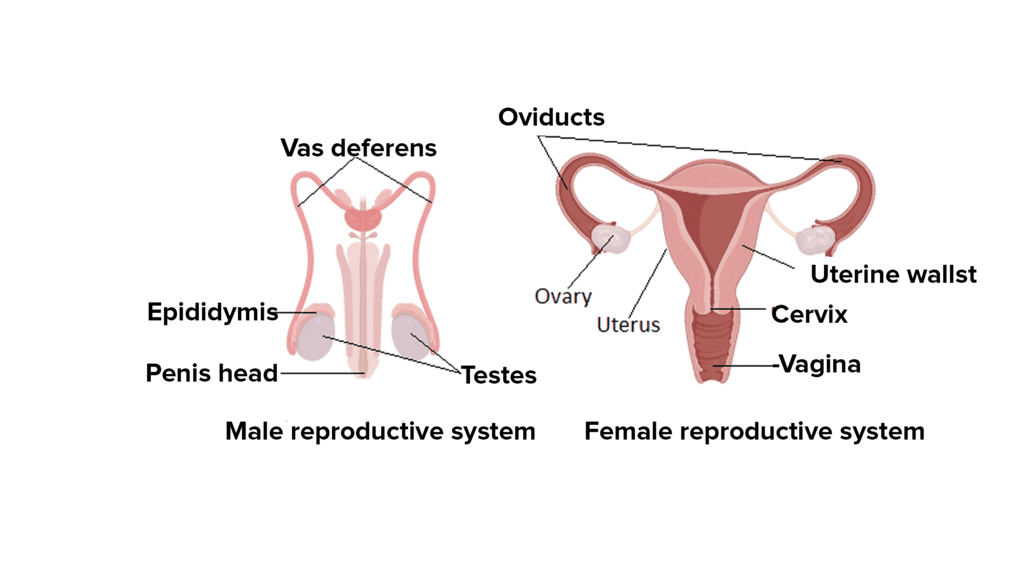JSS 3 Exam > JSS 3 Notes > Basic Science for JSS 3 > Overview: How do Organisms Reproduce? - 2
Overview: How do Organisms Reproduce? - 2 | Basic Science for JSS 3 PDF Download
Reproduction in Human Beings
Human reproduction is a sexual process involving two parents. Offspring result from the fusion of gametes from each parent. Human reproduction is an example of sexual reproduction.
Sexual Dimorphism
Males and females have different reproductive systems

Male Reproductive System
- Produces male gametes (sperms).
- Sperms have a head, middle piece, and a tail.
- Components of Male Reproductive System:
Question for Overview: How do Organisms Reproduce? - 2Try yourself: Which of the following is not a component of the male reproductive system?View Solution
- Testicles (testes): Oval organs responsible for sperm production and testosterone.
- Scrotum: Sac-like organ housing the testes, maintaining the required temperature.
- Vas Deferens: Tube where sperms mature and pass to the urethra.
- Accessory Glands: Seminal vesicles, prostate gland, and Cowper's gland; their secretions form semen.
- Penis: Cylindrical tube serving as a reproductive and excretory organ, delivering sperms during intercourse.
Female Reproductive System
- Active before, during, and after fertilization.
- Components: Ovaries, Fallopian tubes (Oviducts), Uterus, Vagina.
Ovaries
- Produce and store ovum (egg).
- Produce estrogen, a female hormone.
Fallopian Tubes (Oviducts)
- Site of fertilization, connecting ovaries and the uterus.
Uterus
- Site for embryo development.
Vagina
- Connects the cervix to external female body parts.
- Route for the penis during intercourse and fetus during delivery.
Question for Overview: How do Organisms Reproduce? - 2Try yourself: What is the function of the testicles?View Solution
The document Overview: How do Organisms Reproduce? - 2 | Basic Science for JSS 3 is a part of the JSS 3 Course Basic Science for JSS 3.
All you need of JSS 3 at this link: JSS 3
|
114 videos|387 docs|97 tests
|
FAQs on Overview: How do Organisms Reproduce? - 2 - Basic Science for JSS 3
| 1. How do human beings reproduce? |  |
Ans. Human beings reproduce through sexual reproduction. The male reproductive system produces sperm, while the female reproductive system produces eggs. During sexual intercourse, sperm is transferred into the female reproductive system, where it can fertilize an egg. This fertilized egg then implants itself in the uterus and develops into a fetus, which eventually leads to the birth of a baby.
| 2. What is the purpose of reproduction in human beings? |  |
Ans. The purpose of reproduction in human beings is to ensure the survival and continuation of the species. Through reproduction, new individuals are created, allowing for the passing on of genetic information from one generation to the next. This genetic diversity is essential for the long-term adaptation and evolution of the human species.
| 3. What are the different methods of contraception in human beings? |  |
Ans. There are various methods of contraception available to human beings to prevent unwanted pregnancies. Some common methods include barrier methods (such as condoms or diaphragms), hormonal methods (such as birth control pills or patches), intrauterine devices (IUDs), sterilization (such as tubal ligation or vasectomy), and emergency contraception (such as the morning-after pill). It is important to choose a method that is suitable for an individual's needs and consult a healthcare professional for guidance.
| 4. Can human beings reproduce asexually? |  |
Ans. No, human beings cannot reproduce asexually. Unlike certain organisms like bacteria or plants, human beings require the fusion of genetic material from two individuals (one male and one female) to reproduce. This process, known as sexual reproduction, involves the formation of a zygote through the fertilization of an egg by a sperm. Asexual reproduction, where offspring are produced without the involvement of gametes, is not possible in human beings.
| 5. What are the stages of human reproduction? |  |
Ans. The stages of human reproduction can be broadly categorized into four main phases: gametogenesis, fertilization, implantation, and development. Gametogenesis refers to the production of gametes (sperm and eggs) through a process called meiosis. Fertilization occurs when a sperm penetrates and fertilizes an egg, forming a zygote. The zygote then undergoes cell division and travels down the fallopian tube to reach the uterus, where it implants itself into the uterine lining during implantation. From there, the zygote develops into an embryo, fetus, and eventually a fully formed baby.
Related Searches
















